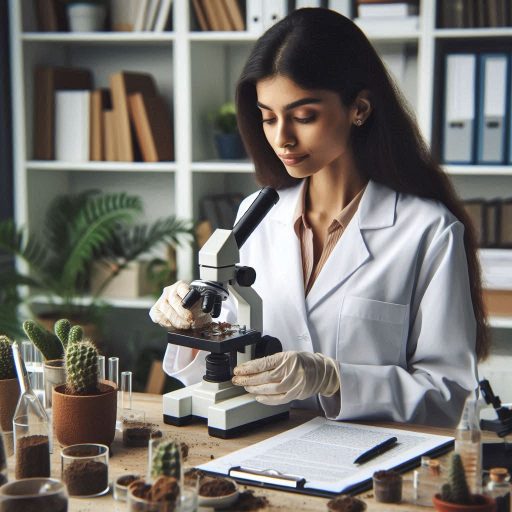Introduction
Soil science is the study of soil as a natural resource, encompassing its formation, classification, and mapping.
It examines the physical, chemical, and biological properties of soil, highlighting its role in sustaining life on Earth.
This field is vital for understanding how soil interacts with the environment and supports various ecosystems.
In agriculture, soil science is crucial for optimizing crop production and ensuring food security.
By analyzing soil health, scientists can develop effective farming practices that enhance soil fertility and minimize degradation.
Healthy soils provide essential nutrients for plants, retain moisture, and support diverse microbial communities that contribute to plant growth.
In ecology, soil science plays a key role in maintaining ecosystem stability.
Soils act as a habitat for countless organisms and are integral to water filtration and carbon storage.
By bridging agriculture and ecology, soil science promotes sustainable practices that benefit both food systems and the environment.
Understanding and investing in soil science is essential for a sustainable future.
What is Soil Science?
Definition of Soil Science
Soil science is the study of soil as a natural resource.
It encompasses the formation, classification, mapping, and management of soils.
Soil scientists analyze soil properties to understand their behavior in different environments.
This field is crucial for agriculture, ecology, and environmental management.
Scope of Soil Science
The scope of soil science is vast and interdisciplinary.
It integrates knowledge from geology, biology, chemistry, and environmental science.
Soil science examines the physical, chemical, and biological properties of soils.
It studies soil formation processes, nutrient cycling, and soil-water relationships.
Understanding these aspects helps optimize land use for agriculture and conservation.
Branches of Soil Science
Soil science has several branches, each focusing on different aspects of soil.
Pedology studies soil formation, classification, and distribution.
Pedologists investigate how soils develop and vary across landscapes, improving our understanding of soil types and properties.
Edaphology focuses on the relationship between soil and living organisms.
Edaphologists assess soil fertility, nutrient availability, and soil management’s impact on crops.
Their research guides sustainable agricultural practices.
Soil chemistry examines the chemical composition of soils and their interactions with plants.
Generally, soil chemists analyze nutrients, pH, and contaminants, ensuring healthy crop production and managing soil fertility.
Soil physics studies soil’s physical properties like texture, structure, and porosity.
Also, soil physicists investigate water movement, aeration, and compaction, helping to improve soil structure and prevent erosion.
Soil microbiology explores the role of microorganisms in soil ecosystems.
Soil microbiologists study bacteria, fungi, and other microbes that contribute to nutrient cycling and soil fertility.
Each branch contributes to sustainable land management, bridging agriculture and ecology.
Soil scientists analyze soil properties and interactions to support food production and environmental protection.
Their work ensures sustainable land use while safeguarding the environment.
Soil science is essential for those interested in agriculture, ecology, or environmental science.
By understanding soil dynamics, we can better appreciate soil’s vital role in sustaining life on Earth.
Soil scientists play a critical role in developing practices that balance productivity with environmental stewardship, ensuring a sustainable future.
Read: Challenges and Rewards: The Dual Life of an U.S. Environmental Scientist
Role of Soil Science in Agriculture
Importance of Soil Quality in Crop Production
Soil quality plays a crucial role in crop production.
Healthy soil provides essential nutrients and water for plants.
It also supports beneficial organisms that enhance plant growth.
Farmers must assess soil quality regularly to ensure optimal conditions for crops.
High-quality soil leads to better yields and healthier plants.
Soil structure significantly affects water retention and drainage.
Well-structured soil promotes root growth and nutrient absorption.
Conversely, compacted or poor-quality soil can hinder crop development.
Furthermore, soil scientists help farmers identify quality issues and recommend improvements.
Soil Fertility and Nutrient Management
Soil fertility is vital for successful agriculture.
Fertile soil contains adequate levels of essential nutrients like nitrogen, phosphorus, and potassium.
These nutrients are necessary for plant growth and development.
Soil scientists analyze soil samples to determine nutrient levels and deficiencies.
Effective nutrient management strategies are essential for maintaining soil fertility.
Farmers can apply fertilizers based on soil test results to correct nutrient imbalances.
Soil scientists also promote sustainable practices, such as crop rotation and cover cropping.
These methods enhance soil fertility and reduce the need for chemical fertilizers.
Impact of Soil Health on Agricultural Sustainability
Soil health directly impacts agricultural sustainability.
Healthy soil supports diverse ecosystems that contribute to plant health.
It helps mitigate issues like erosion, compaction, and nutrient runoff.
Soil scientists advocate for practices that improve soil health over time.
Maintaining soil health is essential for long-term agricultural productivity.
Healthy soils improve water retention and reduce the risk of drought.
They also enhance biodiversity, which benefits pest control and pollination.
By promoting sustainable soil management, soil scientists support resilient farming systems.
Soil science plays a vital role in agriculture.
It informs practices that enhance soil quality, fertility, and health.
By understanding these factors, farmers can improve crop production and sustainability.
Soil scientists provide essential knowledge that helps optimize land use for current and future generations.
Their work ensures that agriculture remains viable while protecting the environment.
Ultimately, investing in soil science is an investment in agricultural success and sustainability.
Read: Job Market Trends: Future of Chemistry Jobs in America
Role of Soil Science in Ecology
Link Between Soil Health and Ecosystem Health
Soil health is intricately linked to ecosystem health.
Healthy soils provide essential nutrients and support diverse plant and animal life.
They help regulate water flow, maintain nutrient cycles, and foster microbial communities.
Soil scientists study these relationships to understand how soil conditions affect broader ecological systems.
When soil health declines, ecosystems suffer.
Erosion, contamination, and nutrient depletion disrupt habitats and biodiversity.
Soil scientists work to identify these issues and develop strategies for restoration.
Promoting healthy soils enhances ecosystem resilience and sustainability.
Importance of Soil for Biodiversity
Soils are home to a vast array of organisms, contributing to global biodiversity.
Microbes, fungi, insects, and earthworms thrive within the soil environment.
These organisms play vital roles in nutrient cycling, organic matter decomposition, and soil structure maintenance.
Their activities support healthy plant growth and diverse ecosystems.
Soil scientists emphasize the importance of preserving soil biodiversity.
They study how different land management practices impact soil organisms.
Sustainable practices, such as reduced tillage and organic farming, promote soil biodiversity.
Healthy soils create a thriving environment for various species, enhancing ecosystem stability.
Soil as a Carbon Sink and Its Role in Climate Change Mitigation
Soils serve as significant carbon sinks, storing carbon in organic matter.
This storage helps mitigate climate change by reducing atmospheric carbon dioxide levels.
Soil scientists investigate how soil management practices influence carbon sequestration.
Their research aims to develop methods for enhancing soil carbon storage.
Practices like cover cropping, agroforestry, and conservation tillage improve soil health while increasing carbon storage.
These methods not only combat climate change but also promote agricultural sustainability.
By enhancing soil carbon sinks, we can support climate resilience and protect ecosystems.
In summary, soil science plays a crucial role in understanding ecological health.
It highlights the interconnectedness of soil health, biodiversity, and climate change mitigation.
Soil scientists work to promote sustainable practices that enhance soil health and ecosystem resilience.
Their efforts contribute to a healthier planet and a more sustainable future for all living organisms.
Investing in soil science is essential for maintaining the delicate balance of our ecosystems and addressing the challenges posed by climate change.
Read: Challenges and Rewards: Navigating the Chemist Career Path

Methods and Tools Used in Soil Science
Soil Sampling Techniques
Soil sampling is a crucial step in soil science research.
Accurate soil samples provide insights into soil properties and health.
Various techniques exist for collecting soil samples effectively.
One common method is the composite sampling technique.
This involves taking multiple small samples from different areas of a field and mixing them together.
This approach provides a more representative sample of the entire area.
Another method is grid sampling, where the field is divided into a grid.
Samples are taken systematically from each grid cell.
This technique helps identify spatial variability in soil properties.
Depth sampling is also important, as soil properties can vary with depth.
Collecting samples from various depths helps researchers understand vertical soil profiles.
Proper sampling techniques ensure reliable data for subsequent analysis.
Soil Analysis Methods
Soil analysis methods fall into three primary categories: chemical, physical, and biological.
Chemical analysis involves assessing nutrient levels, pH, and contamination.
Soil scientists use techniques like spectroscopy and chromatography to analyze soil samples.
These methods determine nutrient availability, essential for effective soil management.
Physical analysis examines soil texture, structure, and moisture content.
Techniques such as sieve analysis and soil moisture tests help scientists understand soil properties.
This information is vital for predicting water retention and drainage characteristics.
Biological analysis focuses on the living organisms within the soil.
Soil microbiologists study microbial communities and their functions.
Techniques like DNA sequencing and culture methods help identify soil microorganisms.
Understanding soil biology is essential for improving soil health and fertility.
Remote Sensing and GIS in Soil Science Research
Remote sensing and Geographic Information Systems (GIS) are powerful tools in soil science.
They allow researchers to analyze large areas efficiently.
Remote sensing uses satellite imagery and aerial photography to assess land use and soil conditions.
GIS technology helps scientists visualize and analyze spatial data.
It integrates various datasets, such as soil types, climate, and vegetation, to identify patterns and relationships.
This information supports decision-making in land management and conservation.
These technologies enhance our understanding of soil variability across landscapes.
They also enable the monitoring of changes in soil health over time.
By combining remote sensing with ground-based observations, researchers can develop effective soil management strategies.
Various methods and tools are essential in soil science research.
Soil sampling techniques provide accurate data, while analysis methods reveal critical soil properties.
Remote sensing and GIS technologies enhance our understanding of soils on a larger scale.
Together, these tools enable soil scientists to make informed decisions for sustainable land use and management.
Investing in these methods contributes to healthier soils and improved agricultural practices.
Read: Diverse Career Paths: From Chemist to Patent Attorney in the US
Challenges and Issues in Soil Science
Soil Degradation and Erosion
Soil degradation is a significant challenge facing global agriculture and ecology.
It refers to the decline in soil quality and productivity due to various factors.
Erosion is one of the main contributors to soil degradation.
Wind and water can strip away the topsoil, which contains essential nutrients.
This loss negatively impacts crop yields and ecosystem health.
Unsustainable agricultural practices, such as over-tillage and monocropping, exacerbate erosion.
They disrupt soil structure and increase vulnerability to erosion.
Soil scientists study these processes to develop strategies for prevention and restoration.
Implementing practices like contour farming and cover cropping can significantly reduce erosion.
Pollution of Soil from Anthropogenic Activities
Soil pollution poses a severe threat to human health and the environment.
Anthropogenic activities, such as industrial processes, agriculture, and urbanization, contribute to soil contamination.
Pesticides, heavy metals, and hazardous waste can degrade soil quality and harm ecosystems.
Soil scientists investigate the sources and impacts of soil pollution.
They develop methods for assessing contamination levels and mitigating pollution effects.
Remediation strategies, such as bioremediation and phytoremediation, can help restore polluted soils.
By addressing soil pollution, we can protect both ecosystems and public health.
Global Soil Health Crisis and the Need for Sustainable Solutions
The world faces a growing soil health crisis.
Factors such as climate change, population growth, and unsustainable land use threaten soil health worldwide.
Declining soil fertility, erosion, and pollution jeopardize food security and ecosystem services.
Addressing this crisis requires sustainable solutions that promote soil health.
Soil scientists advocate for practices that enhance soil quality and resilience.
Techniques such as organic farming, agroecology, and regenerative agriculture can restore soil health while boosting productivity.
Moreover, raising awareness about the importance of soil health is essential.
Educating farmers, policymakers, and the public can drive changes in land management practices.
Collaborative efforts between scientists, governments, and communities are crucial for developing effective soil management strategies.
Soil science faces several significant challenges.
Also, soil degradation, pollution, and the global soil health crisis threaten agricultural sustainability and ecosystem stability.
Soil scientists play a vital role in identifying these issues and developing sustainable solutions.
By promoting healthy soils, we can ensure food security and protect our environment for future generations.
Investing in soil science research and practices is essential for overcoming these challenges and building a sustainable future.
Transform Your Career Today
Unlock a personalized career strategy that drives real results. Get tailored advice and a roadmap designed just for you.
Start NowInnovations in Soil Science
Soil Microbiome Research
Soil microbiome research has emerged as a groundbreaking field within soil science.
This research focuses on the diverse communities of microorganisms living in the soil.
These microbes play crucial roles in nutrient cycling, organic matter decomposition, and plant health.
Understanding the soil microbiome can lead to improved agricultural practices and enhanced soil health.
Recent advancements in molecular techniques have revolutionized microbiome studies.
Methods such as DNA sequencing allow scientists to identify and analyze microbial communities.
This research provides insights into how specific microbes contribute to soil fertility and plant growth.
By harnessing beneficial microorganisms, farmers can improve soil health and reduce reliance on chemical fertilizers.
Precision Agriculture Techniques
Precision agriculture is transforming the way farmers manage their land.
It uses technology to optimize field-level management regarding crop farming.
Soil sensors, drones, and satellite imagery provide real-time data on soil conditions and crop health.
This information allows farmers to make informed decisions about planting, irrigation, and fertilization.
Soil mapping and analysis through precision agriculture help identify spatial variability within fields.
Farmers can apply inputs more accurately, reducing waste and minimizing environmental impact.
By tailoring their practices to specific soil conditions, farmers can enhance yields and maintain soil health.
Sustainable Soil Management Practices
Innovations in sustainable soil management practices are essential for addressing soil health challenges.
These practices focus on enhancing soil fertility while minimizing environmental impacts.
Techniques such as cover cropping, reduced tillage, and crop rotation improve soil structure and nutrient availability.
Agroecology is another innovative approach that integrates ecological principles into farming.
This method promotes biodiversity, enhances soil resilience, and reduces reliance on synthetic inputs.
By fostering a balanced ecosystem, agroecology supports sustainable agriculture and protects soil health.
Additionally, advancements in organic farming techniques continue to evolve.
Organic amendments, such as compost and biochar, improve soil health and fertility.
These practices enhance microbial activity and nutrient cycling, contributing to sustainable soil management.
Innovations in soil science are driving progress in agricultural sustainability.
Soil microbiome research deepens our understanding of soil health and fertility.
Precision agriculture techniques enable farmers to manage their resources more efficiently.
Sustainable soil management practices promote practices that enhance soil quality and resilience.
Together, these innovations pave the way for a more sustainable agricultural future, ensuring food security while protecting our vital soil resources.
Investing in these advancements is crucial for the well-being of both the environment and society.
Conclusion
Soil science plays a crucial role in bridging agriculture and ecology.
It enhances our understanding of soil health, fertility, and biodiversity, directly impacting food production and environmental sustainability.
Healthy soils support robust crop yields and contribute to the overall stability of ecosystems.
Investing in soil research leads to the development of sustainable farming practices that not only improve food security but also promote ecological balance.
Additionally, conservation efforts protect soil from erosion, degradation, and pollution, ensuring its vitality for future generations.
Educating communities about the importance of soil fosters responsible land management practices and encourages sustainable use of resources.
Everyone can contribute to soil health by supporting local agricultural initiatives and participating in soil conservation programs.
Advocating for policies that prioritize soil research and sustainability is essential for protecting this vital resource.
We must raise awareness of soil’s critical role in our environment.
By valuing soil science, we can ensure a healthier planet for future generations.
Let’s take action to protect our soil and promote its health today!
[E-Books for Sale]
The Big Book of 500 High-Paying Jobs in America: Unlock Your Earning Potential
$19.99 • 500 High-Paying Jobs • 330 pages
Explore 500 high-paying jobs in America and learn how to boost your career, earn more, and achieve success!
See All 500 High-Paying Jobs of this E-Book
1001 Professions Without a Degree: High-Paying American Jobs You Can Start Now
$19.99 • 1001 Professions Without a Degree • 174 pages
Discover 1001 high-paying jobs without a degree! Unlock career tips, skills, and success strategies for just $19.99!




